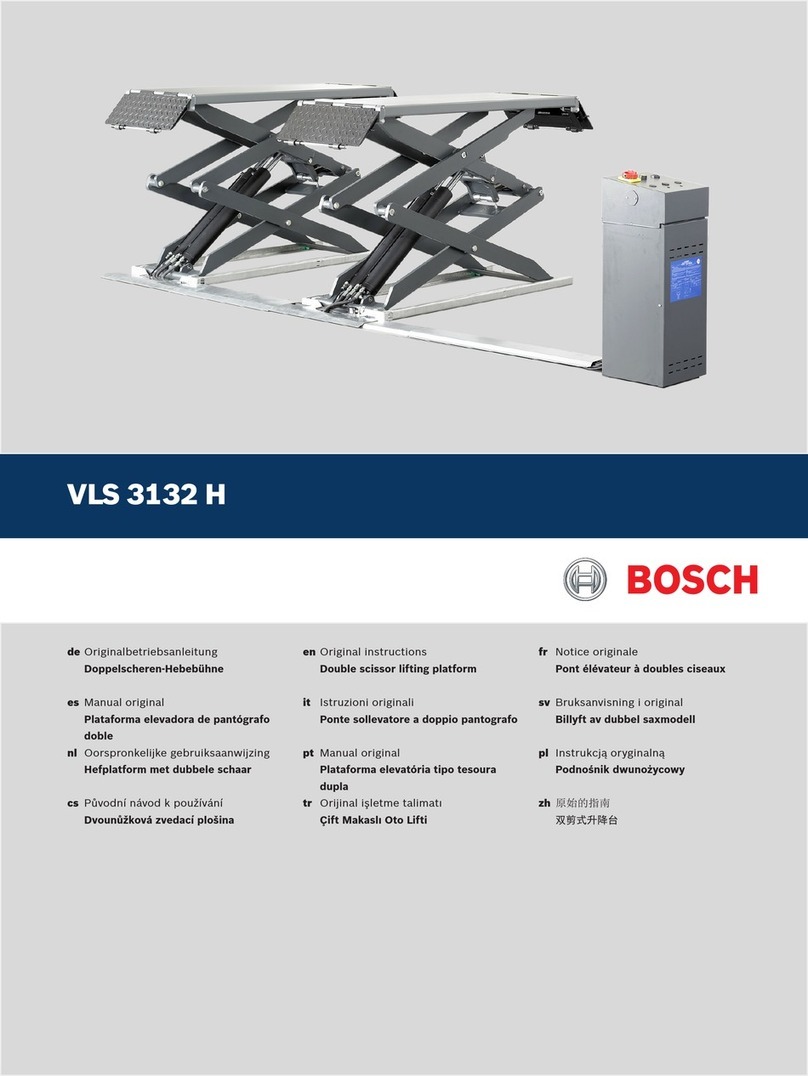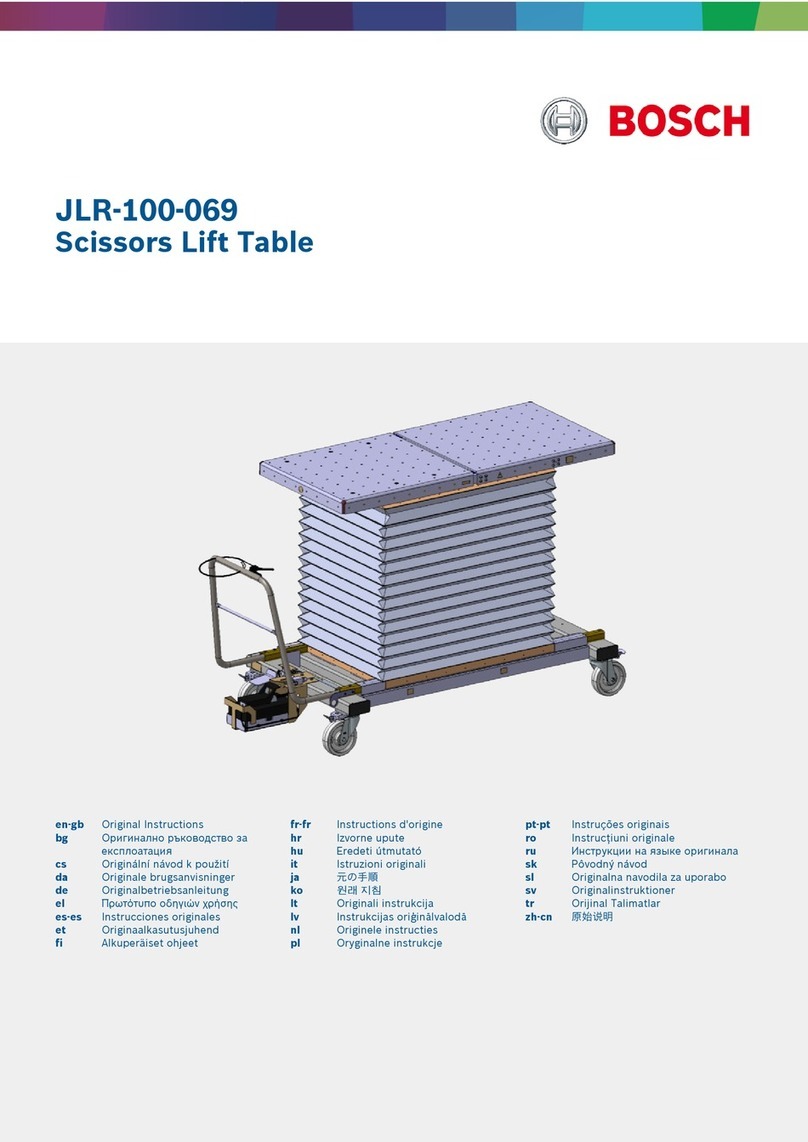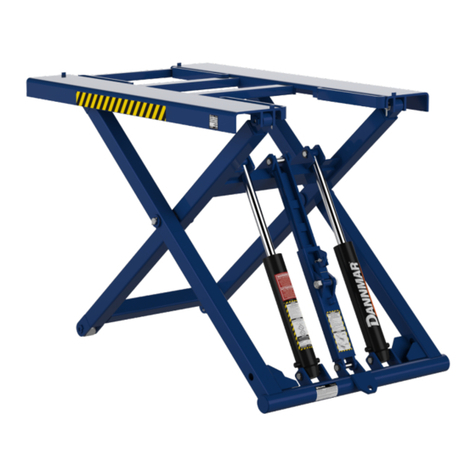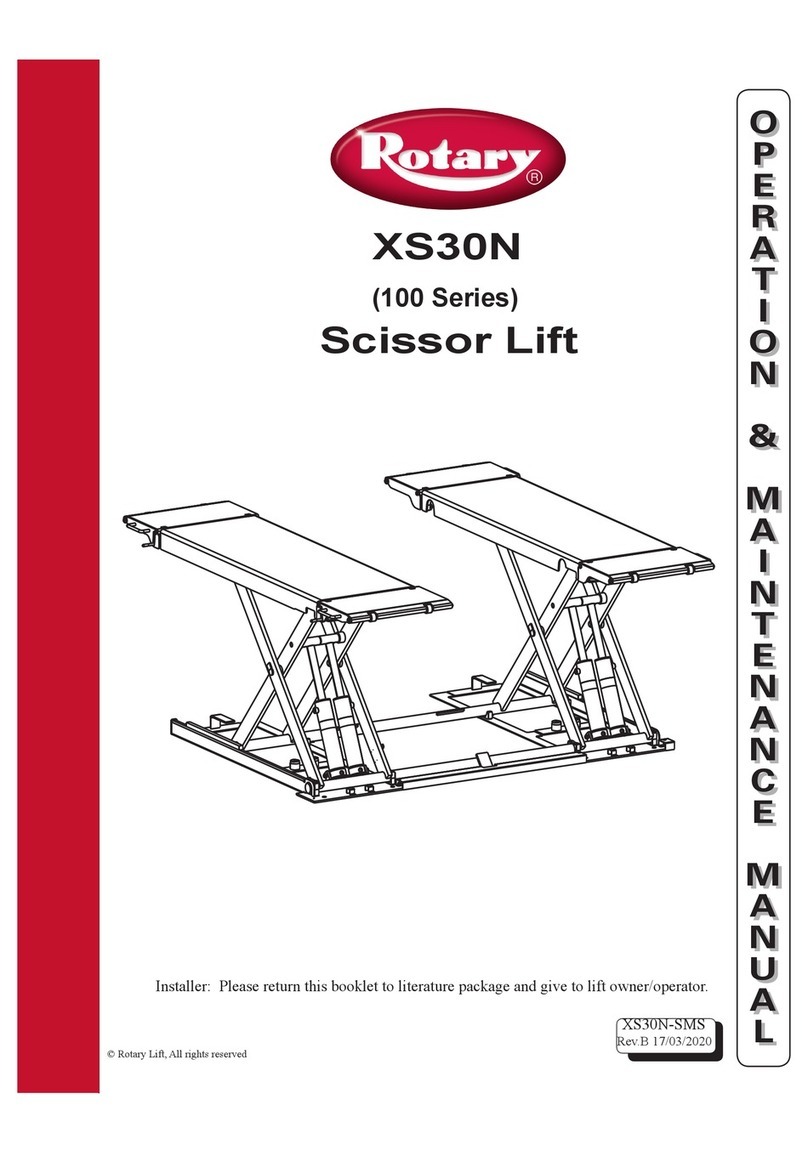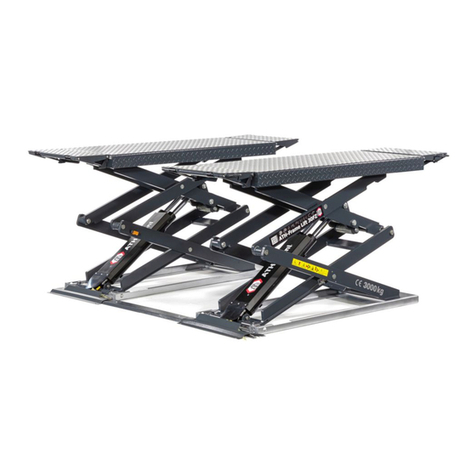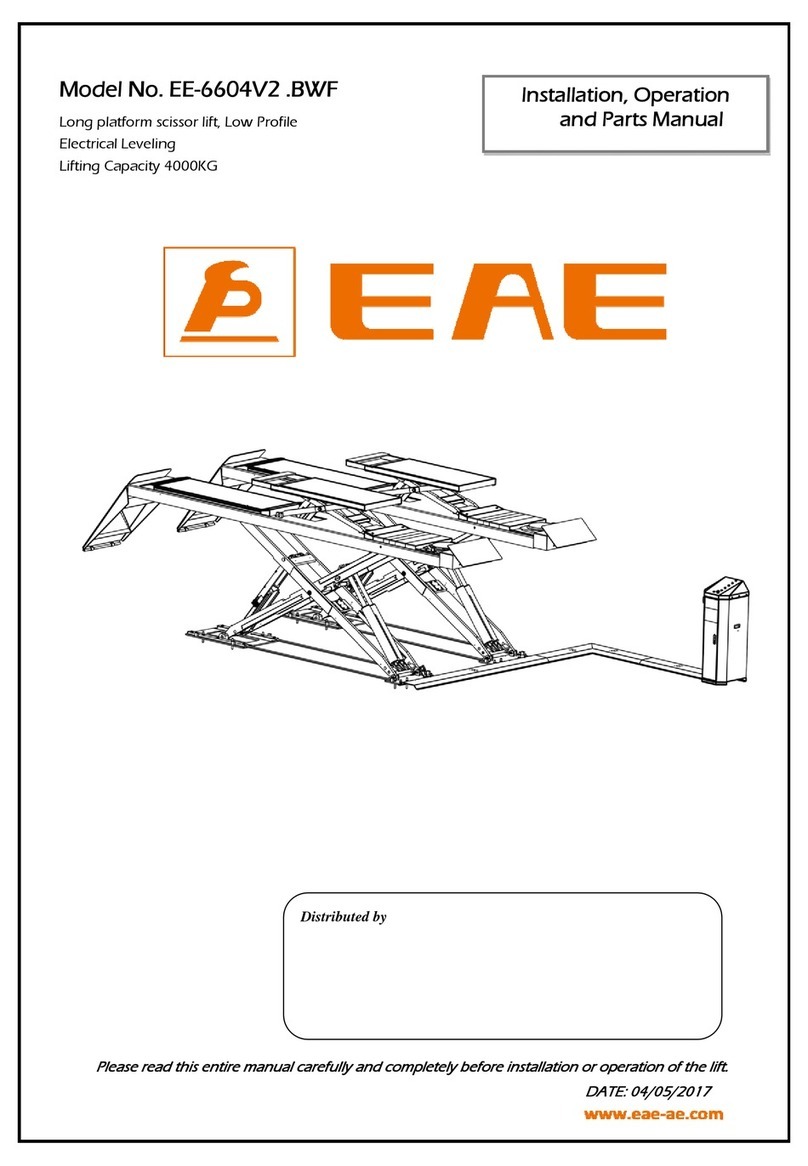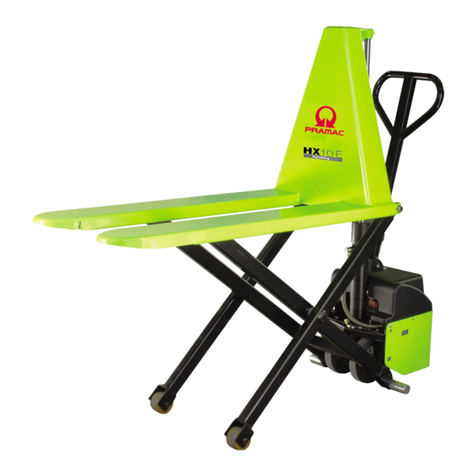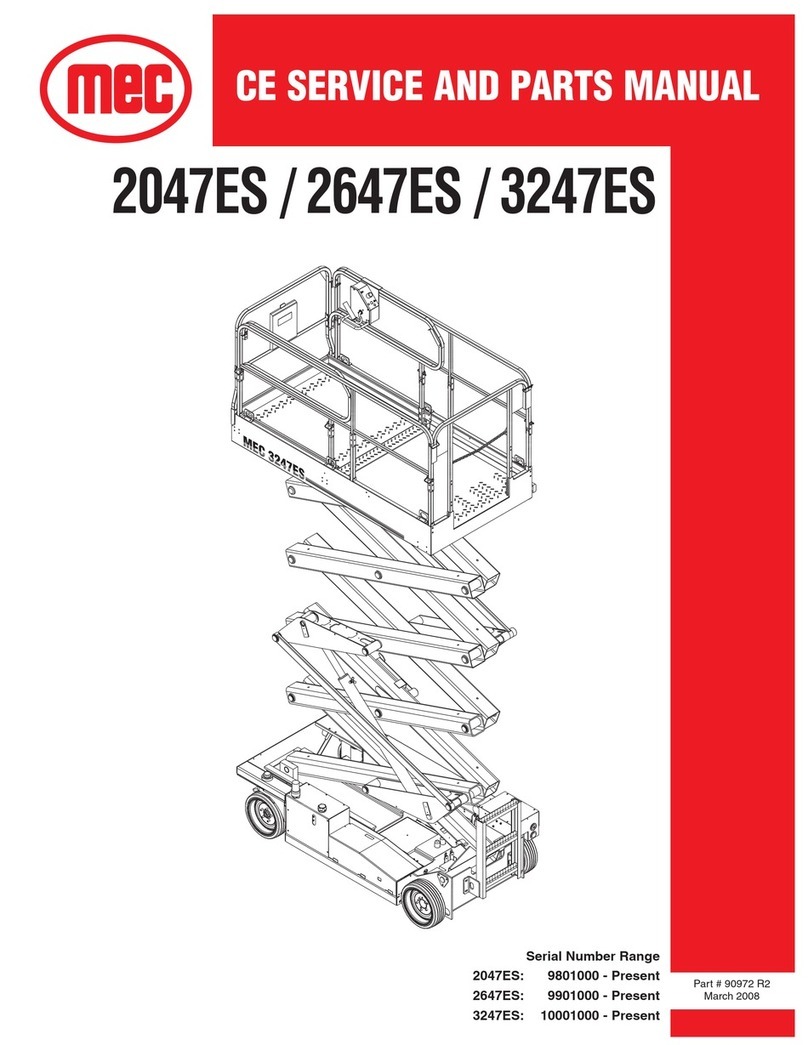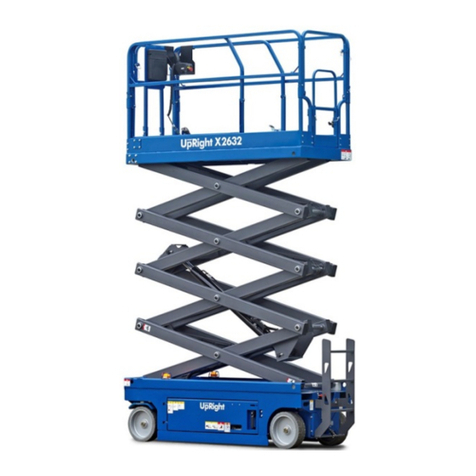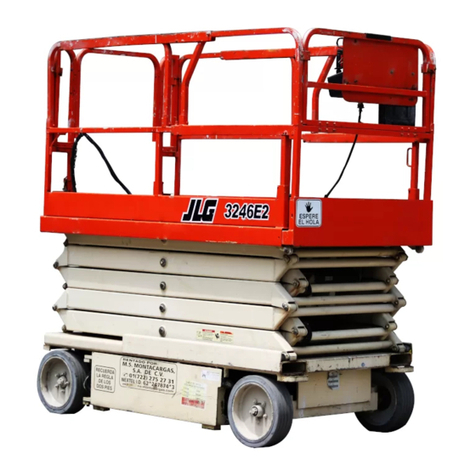Bosch VLS 5235 User manual

VLS 5235
en
Original instructions
Scissor lift
zh
原始的指南
剪式举升机

1 697 090 700 2014-04-10| Robert Bosch GmbH
2 | VLS 5235 |

1 697 090 700 2014-04-10| Robert Bosch GmbH
4 | VLS 5235 |en
Contents
1. Symbols used 5
1.1 In the documentation 5
1.1.1 Warning notices -
Structure and meaning 5
1.1.2 Symbols in this documentation 5
1.2 On the product 5
2. Important notes 6
3. Safety instructions 6
3.1 Mains voltage 6
3.2 Risk of injury, danger of crushing 6
4. Obligations of the plant operator 7
4.1 Operation of lifting platforms 7
4.2 Checking of lifting platforms 7
4.2.1 Scope of checking 7
4.2.2 Regular checking 7
4.2.3 Exceptional checking 7
4.3 Inspection log 8
5. Product Description 8
5.1 Designated use 8
5.2 Floor-mounted and underfloor versions 8
5.3 Authorized users 9
5.4 Preparation by the user 9
5.4.1 Space requirements 9
5.4.2 Foundation and connections 9
5.5 Transportation information 9
5.5.1 Package specification 9
5.5.2 Lifting and handling 9
5.6 Set-up and initial commissioning 9
5.7 Scope of delivery 9
5.8 Special accessories 10
5.9 Important safety note 10
5.10 Warning labels 10
5.11 Noise level 11
5.12 Construction of the lift 11
5.13 Dimension 11
5.14 Safety devices descriptions 11
5.15 Technical data 12
6. Operation 12
6.1 Essential points for operation 12
6.2 Flow chart for operation 13
6.3 Switch-on 13
6.4 Preparation 13
6.5 Driving the vehicle into position 13
6.6 Operation instructions 14
6.6.1 Raise vehicle using the Runways 14
6.6.2 Lower vehicle 14
6.6.3 Raise auxiliary lift 15
6.6.4 Lower Auxiliary lift 15
7. Note on Troubleshooting 16
7.1 Faults during runway operation 16
7.2 Faults during operation of auxiliary lift 16
8. Maintenance 17
8.1 Important notes on maintenance 17
8.2 Cleaning 17
8.3 Maintenance by the user 17
8.3.1 Maintenance agreement 17
8.3.2 Maintenance schedule 18
8.3.3 Regularly lubricate below positions 18
9. Decommissioning 19
9.1 Temporary shutdown 19
9.2 Change of location 19
9.3 Disposal and scrapping 19
9.3.1 Substances hazardous to water 19
9.3.2 VLS 5235 and accessories 19
10. Floor plan 20

1 697 090 700 2014-04-10|Robert Bosch GmbH
Symbols used | VLS 5235 | 5VLS 5235 | 5| 5 en
1. Symbols used
1.1 In the documentation
1.1.1 Warning notices - Structure and meaning
Warning notices warn of dangers to the user or people
in the vicinity. Warning notices also indicate the
consequences of the hazard as well as preventive action.
Warning notices have the following structure:
Warning
symbol
KEY WORD – Nature and source of hazard!
Consequences of hazard in the event of
failure to observe action and information
given.
¶Hazard prevention action and information.
The key word indicates the likelihood of occurrence and
the severity of the hazard in the event of non-observance:
Key word Probability of
occurrence
Severity of danger if
instructions not observed
DANGER Immediate impend-
ing danger
Death or severe injury
WARNING Possible impending
danger
Death or severe injury
CAUTION Possible dangerous
situation
Minor injury
1.1.2 Symbols in this documentation
Symbol Designation Explanation
!Attention Warns about possible property damage.
iInformation Practical hints and other
useful information.
1.
2.
Multi-step
operation
Instruction consisting of several steps.
eOne-step
operation
Instruction consisting of one step.
Intermediate
result
An instruction produces a visible inter-
mediate result.
"Final result There is a visible final result on com-
pletion of the instruction.
1.2 On the product
!Observe all warning notices on products and ensure
they remain legible.
DANGER – Exposure of live parts on
opening the VLS 5235!
Risk of (fatal) injury or heart failure
from electric shocks on contact with live
components (e.g. master switch, printed
circuit boards).
¶Work on electrical installations or
equipment is only to be performed by
qualified electricians or trained personnel
under the guidance and supervision of an
electrician.
¶Disconnect the VLS 5235 from the mains
before opening.
Disposal
Dispose of used electrical and electronic
devices, including cables, accessories and
batteries, separately from household waste.
Riding on the runways or in the vehicle is
prohibited.
Notes on load distribution
In the case of maximum load, the front/rear load
distribution must not exceed the following ratios:
RRunway: 2 : 1
RAuxiliary lift: 3 : 2

1 697 090 700 2014-04-10| Robert Bosch GmbH
6 | VLS 5235 | Important notesen
2. Important notes
Before start up, connecting and operating
Bosch products it is absolutely essential
that the operating instructions/owner’s
manual and, in particular, the safety
instructions are studied carefully. By doing so you can
eliminate any uncertainties in handling Bosch products
and thus associated safety risks upfront; something
which is in the interests of your own safety and will
ultimately help avoid damage to the device. When a
Bosch product is handed over to another person, not
only the operating instructions but also the safety
instructions and information on its designated use must
be handed over to the person.
By using the product you agree to the following
conditions:
Copyright
The enclosed instructions are the property of
BoschAutomotiveDiagnosticsEquipment(Shenzhen)Limited
or its supplier, and are protected against
duplication and reproduction by copyright laws,
international agreements, and other domestic
legislation. The reproduction or disclosure of
instructions or an extract thereof is prohibited
and offenders are liable to prosecution;
BoschAutomotiveDiagnosticsEquipment(Shenzhen)Limited
reserves the right to initiate criminal proceedings and
assert claims for damages in the event of infringements.
Warranty
The use of non-approved hardware will result in a
modification of our products and thus to the exclusion
of any liability or warranty, even if such hardware has
been removed again in the interim.
It is not permissible to make any changes to our
products and these are only to be used together with
genuine accessories and genuine replacement parts.
Otherwise any warranty claims will be invalid.
Liability
The liability of
BoschAutomotiveDiagnosticsEquipment(Shenzhen)Limited
is limited to the amount that the customer has
actually paid for this product. This exclusion of
liability does not apply to damages caused through
willful misconduct or gross negligence on the part of
BoschAutomotiveDiagnosticsEquipment(Shenzhen)Limited.
3. Safety instructions
3.1 Mains voltage
Insulation damage and other faults may result
in accessible components being live.
Safety measures:
¶Only ever use the power cord provided or a tested
power cord.
¶Replace wires with damaged insulation.
¶Do not open the operating unit.
3.2 Risk of injury, danger of crushing
In the event of excessive vehicle weight,
incorrect mounting of the vehicle or on removing
heavy objects, there is a risk of the vehicle falling
off the lifting platform or tipping up.
Safety measures:
¶The lifting platform is only ever to be employed for
the intended purpose.
¶Carefully study and heed all the information given in
Section 6.1.
¶Observe the warning notices for operation (Section 6).

1 697 090 700 2014-04-10|Robert Bosch GmbH
Obligations of the plant operator | VLS 5235 | 7VLS 5235 | 7| 7 en
4. Obligations of the plant
operator
4.1 Operation of lifting platforms
In Germany, the use of lifting platforms is governed
by the mandatory "Employers' liability insurance
association regulations on health and work safety
as defined in BGR 500 Section 2.10". In all other
countries, the applicable national regulations, laws and
directives must be observed.
4.2 Checking of lifting platforms
Checks are to be based on the following directives and
regulations:
RBasic principles for testing lifting platforms (BGG 945)
RThe basic health and safety requirements stipulated
in the directive 2006/42/EC
RHarmonized European standards
RThe generally acknowledged rules of engineering
RThe directive on the use of equipment 89/655/EEC
RThe applicable accident prevention regulations
The checks are to be organized by the user of the
lifting platform. The user is responsible for appointing
an expert or qualified person to perform checking.
It must be ensured that the person chosen satisfies the
requirements of BGG 945 as per Section 3.
!The user bears special responsibility if employees of
the company are appointed as experts or qualified
persons.
4.2.1 Scope of checking
Regular checking essentially involves performing a
visual inspection and a functional test. This includes
checking the condition of the components and
equipment, checking that the safety systems are
complete and functioning properly and that the
inspection log book is completely filled in.
The scope of exceptional checking depends on the
nature and extent of any structural modification or
repair work.
4.2.2 Regular checking
After initial commissioning, lifting platforms are to be
checked by a qualified person at intervals of not longer
than one year.
A qualified person is somebody with the training and
experience required to possess sufficient knowledge
of lifting platforms and who is sufficiently familiar
with the pertinent national regulations, accident
prevention regulations and generally acknowledged
rules of engineering (e.g. BG rules, DIN Standards, VDE
provisions, the technical regulations of other European
Union member states or other parties to the agreement
in the European economic area) to be able to assess
the safe operating condition of lifting platforms.
4.2.3 Exceptional checking
Lifting platforms with a lift height of more than
2 meters and lifting platforms intended for use with
people standing under the loadbearing elements or
the load are to be checked by an expert prior to re-use
following structural modifications and major repairs to
loadbearing components.
An expert is somebody with the training and experience
required to possess specialist knowledge of lifting
platforms and who is sufficiently familiar with the
pertinent national work safety regulations, accident
prevention regulations and generally acknowledged
rules of engineering (e.g. BG rules, DIN Standards, VDE
provisions, the technical regulations of other European
Union member states or other parties to the agreement
on the European economic area) to be able to check
and give an expert opinion on lifting platforms.

1 697 090 700 2014-04-10| Robert Bosch GmbH
8 | VLS 5235 | Product Descriptionen
4.3 Inspection log
An inspection log is to be kept as a record of the lifting
platform checks performed. The inspection log book
must contain a report on the test performed prior to
initial commissioning and the regular and exceptional
checks, as well as the applicable certification on (EC)
type testing and the EC declaration of conformity.
The report must include:
RThe date and scope of testing with details of any test
items not yet performed
RThe results of the test with details of any
shortcomings established
RAn assessment of whether there are any
impediments to start-up or further use
RThe details of any follow-up testing required
RThe name, address and signature of the person
carrying out the checks
iThe acknowledgement and rectification of any
shortcomings found must be confirmed by the plant
operator in the report.
5. Product Description
5.1 Designated use
The type-approved lifting platform VLS 5235 is intended
solely for the following use:
RLifting of passenger/motor vehicles using the
runways.
RLifting of passenger/motor vehicles using the
auxiliary lift.
RAdditionally for the VLS 5235:
Wheel alignment using the sliding plates
(optional turntables required).
The limit values for load-bearing capacity and load
distribution must be complied with.
The following regulations must be observed when
starting up and operating lifting platforms:
RRules for lifting platform operation (BGR 500)
RBasic principles for testing lifting platforms
(BGG 945)
RRules for keeping the inspection log (BGG 945-A2)
The lifting platform is not to be used as a crane or as
a support for other lifting mechanisms (e.g. block and
tackle).
The lifting platform is designed such that people
can stand under the loadbearing elements. It is not
equipped to permit walking on the lifting platform or
for conveying people.
Erection of the lifting platform is prohibited in
explosion and fire hazard areas, outdoor areas and in
damp atmospheres (e.g. washing shops).
The original operating instructions must be kept in
a conspicuous, constantly accessible location near
the lifting platform. All the above regulations must be
heeded as well as the applicable rules on work safety
and accident prevention.
5.2 Floor-mounted and underfloor
versions
This documentation describes only the under floor
version of the VLS 5235.
The above floor version is identical in terms of
technology but is supplied with 2 Drive-on ramps
instead of 4 Drive-on flaps.

1 697 090 700 2014-04-10|Robert Bosch GmbH
Product Description | VLS 5235 | 9VLS 5235 | 9| 9 en
5.3 Authorized users
Only users aged 18 or above who have been instructed
on how to operate the lifting platform and have proven
their ability to do so to the owner are to be entrusted
with unsupervised operation of lifting platforms. The
task of operating the lifting platform must be expressly
assigned to users by the owner. Authorization to
operate lifting platforms must be granted in writing.
Before loading a vehicle onto the lifting platform, users
should study the original operating instructions and
familiarize themselves with the operating procedures in
several trial runs.
5.4 Preparation by the user
5.4.1 Space requirements
Refer to Charter 10 for the dimensions of the lifting
platform.
There must also be a clearance of at least 1 meter
between the lifting platform and fixed elements
(e.g. wall) in all lifting positions.
There must be sufficient space at the ends of the lifting
platform for driving vehicles on and off.
iTo stop vehicles colliding with the ceiling, it is
advisable to fit an overhead light barrier in low-
ceilinged buildings.
5.4.2 Foundation and connections
The user must have the following work performed
before erecting the platform:
RConstruction of the foundation following
consultation with Bosch customer service or an
authorized service agent.
RRouting of the wiring to the installation location.
The user must provide fuse protection for the
connection.
RRouting of the compressed air connection to the
installation location. The user must install a service
unit upstream of the connection.
iRefer also to the corresponding information in the
commissioning instructions.
5.5 Transportation information
Packing, lifting, handling, transporting operations must
be performed only by experienced personnel with
appropriate knowledge of the lift and after reading this
manual.
5.5.1 Package specification
Packing unit Dimensions Weight
1 x package(Operation unit) 580 x 510 x 1010 mm 100 kg
1 x package(Main runway) 4712 x 632 x 446 mm 1075 kg
1 x package(Secondary run-
way)
4712 x 632 x 446 mm 1075 kg
5.5.2 Lifting and handling
The packs can be lifted and transported only by using
lift trucks. The center of gravity and lashing points are
marked on the packaging.
Never attempt to hoist or transport the unit using lifting
slings.
5.6 Set-up and initial commissioning
The lifting platform is only to be started up by Bosch
customer service or an authorized service agent. Initial
commissioning of the lifting platform is described in the
installation instructions. Acceptance must be performed
by a qualified person after initial commissioning.
5.7 Scope of delivery
Description Order no.
Lifting platform VLS 5235, complete 1 697 000 935
Original operating instructions 1 697 090 700
Quality card 1 697 090 701
Warranty card 1 697 090 702

1 697 090 700 2014-04-10| Robert Bosch GmbH
10 | VLS 5235 | Product Descriptionen
5.9 Important safety note
RDo not install the lift on any asphalt surface.
RRead and understand all safety warnings before
operating the lift.
RDo not leave the controls while the lift is still in
motion.
RKeep hands and feet away from any moving parts.
Keep feet clear of the lift when lowering.
ROnly these properly trained personnel can operate
the lift.
RDo not wear unfit clothes such as large clothes with
flounces, tires, etc, which could be caught by moving
parts of the lift.
RTo prevent evitable incidents, surrounding areas of
the lift must be tidy and with nothing unconcerned.
RThe lift is simply designed to lift the entire body of
vehicles, with its maximum weight within the lifting
capacity.
RAlways insure the safety locks are engaged before
any attempt to work near or under the vehicle. Never
remove safety related components from the lift. Do
not use if safety related components are damaged or
missing.
RDo not rock the vehicle while on the lift or remove
any heavy component from vehicle that may cause
excessive weight shift.
RCheck at any time the parts of the lift to ensure
the agility of moving parts and the performance of
synchronization. Ensure regular maintenance and
if anything abnormal occurs, stop using the lift
immediately and contact our dealers for help.
RLower the lift to its lowest position and do
remember to cut off the power source when service
finishes.
RDo not modify any parts of the lift without
manufacturer’s advice.
RIf the lift is going to be left unused for a long time,
users are required to:
$Disconnect the power.
$Empty the oil tank.
$Lubricate the moving parts with hydraulic oil.
iFor environment protection, please dispose the
disused oil in a proper way.
5.10 Warning labels
All safety warning labels are clearly depicted on the lift
to ensure that the operator is aware of and avoid the
dangers of using the lift in an incorrect manner. The
labels must be kept clean and they have to be replaced
if detached or damaged. Please read carefully the
meaning of each label and memories them for future
operation.
PROHIBITION1: No person under the vehicle while
operating the lift.
PROHIBITION2: Never try to lift or lower only one
platform.
PROHIBITON3: Never try to lift beyond the rated lifting
capacity.
PROHIBITION4: Only trained technicians are permitted
to operate this lift.
PROHIBITION5: Do not change, tamper or interfere with
the safety mechanisms of this lift.
PROHIBITION6: Do not shake or push the vehicle while
it is on the lift.
PROHIBITION7: Ensure feet and other parts of your
body are well clear of the lift when it is being lowered
or when lifting.
PROHIBITION8: Persons are not permitted to stand
on or sit on the platforms during the lifting process or
when the vehicle is already lifted.
CAUTION1: When the lift is lowered, no auxiliary stand
or other blocking objects should be near the lift.
CAUTION2: Always keep the lifts pit clean and clear of
any objects or contaminants.
CAUTION3: High voltage in control box, take extreme
caution here.
CAUTION4: Ensure that the lifting weight of the vehicle
is balanced on both platforms to avoid tilting or sliding.
INSTRUCTION1: The operator should not stand too
close to the lift but in a safe position away from moving
parts.
INSTRUCTION2: Please read and study the operation
manual carefully before operating this lift.
INSTRUCTION3: Keep the vehicle parallel with the
platform lifts at all times.
INSTRUCTION4: The area beneath or surrounding the
lift must be clean.Remove any oil spills immediately to
avoid risk of slipping.
5.8 Special accessories
Information on special accessories can be obtained
from your authorized Bosch dealer.

1 697 090 700 2014-04-10|Robert Bosch GmbH
Product Description | VLS 5235 | 11VLS 5235 | 11| 11 en
5.11 Noise level
Noise emitted during operating the lift should be
less than 70dB. For your health consideration, it is
suggested to place a noise detector in your working
area.
5.12 Construction of the lift
This model is specially designed for lifting motor
vehicles. It is electro-hydraulic powered and mainly
composed by two lifting platforms and two auxiliary
lifts and a set of power unit. The gear pump works
when power supply is connected and meanwhile oil in
the pump will push upwards the pistons of oil cylinders.
Thus, scissor arms of the lift rise accordingly.
Fig. 1: Construction
1 Base plate assembly
2 Arm of the lifting platform
3 Cylinder of the lifting platform
4 Lifting platform
5 Cylinder of auxiliary lift
6 Arm of auxiliary lift
7 Lifting platform of auxiliary lift
5.13 Dimension
Fig. 2: Dimension(Unit: mm)
5.14 Safety devices descriptions
Fig. 3: Safety devices
No. Safety device Function
1 Lowering limit
switch of lifting
platform
The lifting platforms will automatically
stop lowering at 500mm height above
the ground. It needs to push DOWN II
button to continue the lowering move-
ment, meanwhile alarming buzzer will
be heard warning service persons be-
ing away from the moving parts.
2 Raising limit
switch for lifting
platform
Make the lifting platform stop rais-
ing when reach a height of 1850mm
above the ground.
3 Raising limit
switch for the aux-
iliary lift
Make the auxiliary lift stop rising
when reaches a height of 450mm
above lifting platform.
4 Tip-up protection
of lifting platforms
Protect lifting platform from tipping-
up, in case load on it is not evenly dis-
tributed.
5 Tip-up protection
of the auxiliary lift
Protect auxiliary lift from tipping-up,
in case load on it is not evenly distrib-
uted.
6 Mechanical lock
for lifting platform
Protect the lifting platform from fall-
ing down in case oil cylinders loss
forces caused by break down of hy-
draulic system.
7 Mechanical lock
for the auxilia-
ry lift
Protect the auxiliary lift from falling
down in case oil cylinders loss forc-
es caused by break down of hydrau-
lic system.
8 Wheel retainer Protect wheels of vehicle from rolling
off the platform.
9 Laser protection
unit
Protect vehicle from rollover by stop-
ping lowering or rising movement in
case the two platforms are not syn-
chronized.
10 Anti-surge valve Slow down the falling speed of lifting
platform in case there is leakage of
hydraulic oil hoses.
11 24V operation
voltage
Safety voltage for operators.

1 697 090 700 2014-04-10| Robert Bosch GmbH
12 | VLS 5235 | Operationen
5.15 Technical data
Items Parameter
Rated load capacity 3500KG
Length of platform 4300mm
Width of vehicle 1600-2100mm
Wheel base 2100-3200mm
Full rise height 1850mm
Full lowered height 330mm
Full rise time with load ≤50s
Full lowered time with load ≤30s
Max working hydraulic pressure 24MPa
Min working hydraulic pressure 22MPa
Max working pneumatic pressure 8kg/cm²
Min working pneumatic pressure 6kg/cm²
Load capacity of secondary lift 3.5ton
Lifting height of secondary lift 450mm
Oil Volume 18L
Tab. 1: VLS 5235
Items Parameter
Capacity 2.2KW
Voltage 380V
Phase 3P
Current 4.6A
Frequency 50HZ
Rotation speed 2880r/m
IP 44
Tab. 2: Motor
Items Parameter
Max working pressure 35MPa
Min bending diameter 100mm
Burst pressure 140Mpa
Tab. 3: Oil hose
6. Operation
6.1 Essential points for operation
¶Only authorized, trained personnel aged 18 years or
older are permitted to operate the lifting platform.
¶Only passenger cars or motor vehicles with a
maximum overall weight of 3500kg may be lifted.
¶In the case of maximum load, the front/rear load
distribution must not exceed 2 : 1.
¶Only vehicles with a wheelbase permitting full
contact between the tyres and runways may be
lifted.
¶The lifting platform must only be operated via the
supplied operating unit.
¶Before moving the lifting platform, make sure that
there are no persons within the danger zone, and
that no objects are leaning against or positioned on
the vehicle or lifting platform.
¶No unauthorized personnel must be allowed in the
vicinity of the lifting platform.
¶Riding on the lifting platform or in the raised vehicle
is prohibited.
¶Do not use the lifting platform as a crane or a
support for other lifting mechanisms (e.g. pulley).
¶Electric welding work on the raised vehicle or on the
lifting platform itself is only permitted if the master
switch is turned to OFF (O).
¶Never use the lifting platform in the event of
malfunction or component damage.
¶If the lifting platform malfunctions, shut it down
immediately, secure it against unauthorized use,
and notify Bosch customer service or an authorized
service outlet.
¶Lock the master switch when not in use.
Please also note the following when using the auxil-
iary lift:
¶Only passenger cars or motor vehicles with a
maximum overall weight of 3500 kg may be lifted.
¶In the case of maximum load, the front/rear load
distribution must not exceed 3 : 2.
¶Lift vehicles only by the four lifting points specified
by the vehicle manufacturer.
¶Certain special-purpose vehicles must not be lifted
using a auxiliary lift. Before lifting any vehicle, you
must establish whether it is such a special-purpose
vehicle.

1 697 090 700 2014-04-10|Robert Bosch GmbH
Operation | VLS 5235 | 13VLS 5235 | 13| 13 en
6.2 Flow chart for operation
Fig. 4: Flow chart of raising
Fig. 5: Flow chart of lowering
6.3 Switch-on
Switch on the VLS 5235 by way of the master switch.
¶Set the master switch to the ON (I) position.
"Lifting platform is ready for operation.
6.4 Preparation
1. Make sure that the runway is completely lowered.
2. Make sure that the auxiliary lift is completely
lowered.
3. Remove any tools, dirt, grease, and oil from the
vicinity of the lifting platform.
"The vehicle can now be driven onto the lifting platform.
6.5 Driving the vehicle into position
DANGER – Incorrect positioning of vehicle!
Risk of (fatal) injury due to the vehicle falling
or tipping during lifting or lowering and when
working on the vehicle.
¶Drive the vehicle into position exactly as
described.
1. Drive the vehicle in a straight line to the center
of the lifting platform. The wheels on each side
of the vehicle must be on the center line of the
corresponding runway.
2. Stop the vehicle and secure in position by applying
the parking brake or engaging a gear.
3. Exit the vehicle.
4. Check the position of the vehicle.
"The vehicle is now positioned on the lifting platform.

1 697 090 700 2014-04-10| Robert Bosch GmbH
14 | VLS 5235 | Operationen
6.6 Operation instructions
DANGER – Risk of vehicle falling or tipping!
Risk of (fatal) injury when lifting (or raising) the
runway.
¶Make sure that the vehicle is correctly
positioned and secured against rolling.
¶Make sure that there are no persons in
the vehicle or in the vicinity of the lifting
platform.
¶Keep a safe distance from the lifting
platform.
¶Observe the lifting platform and vehicle.
¶Make sure that both runways lower evenly
when setting down in the setting-down
position.
6.6.1 Raise vehicle using the Runways
1. Drive and park the vehicle midway between two
platforms. Make sure the vehicle is correctly
positioned and secured against rolling.
2. Turn the optional switch on the control panel to
“Lifting platform” and the switches in the control
unit to “working” and “infrared on”.
3. Push the “UP” button on the control panel to lift the
vehicle a bit higher from the ground and check again
if the vehicle is in a safe position.
4. Having raised the vehicle to the height needed, push
the “Safety Lock” button to ensure the mechanical
safety lock is engaged. Press the “Emergency Stop”
and check again the stability before performing
maintenance or repair work.
6.6.2 Lower vehicle
1. Switch on.
2. Press ”DOWN I” button to lower the lift. It will stop
lowering when clearance between the platforms and
the ground reaches to 500mm.
3. Press “DOWN II” button to continue lowering the
platforms. Alarming buzz will be heard.

1 697 090 700 2014-04-10|Robert Bosch GmbH
Operation | VLS 5235 | 15VLS 5235 | 15| 15 en
6.6.3 Raise auxiliary lift
1. Turn the optional switch on the control panel to
“Auxiliary lift”.
2. Place rubber pads under the pick-up positions of
vehicle. When it is necessary to use the platform
extensions, press “UP” button to raise platforms of
the jack a bit over the platforms of main lift and pull
out the extensions.
3. Press “UP” button and check again if the rubber
pads are directly under the pick-up points of the
vehicle, when they are very close to the vehicle’s
chassis.
4. Keep on pressing ”UP” button until reaches to the
height wanted. Full rise of the jack is 450mm over
the platform of main lift.
5. Press the “Safety Lock” button making mechanical
locks of the jack fully engaged before service work.
6.6.4 Lower Auxiliary lift
iIn case the platform extensions of the jack are used,
the operator needs to push them in when wheels of
the serviced vehicle fall on steadily the platforms of
the main lift
1. Turn the optional switch on the control panel to
"Auxiliary lift".
2. In the case height of the lifting platform is more than
500mm over the floor, press "DOWN I" button on the
control panel to lower the jack, while the height is
less than 500mm, press "DOWN II" button to lower
the jack. Alarming buzz will be heard when pressing
"DOWN II" button.
3. Take away rubber pads.

1 697 090 700 2014-04-10| Robert Bosch GmbH
16 | VLS 5235 | Note on Troubleshootingen
7. Note on Troubleshooting
!Should any faults occur which are not listed below, immediately de-energize the lifting platform, shut it down,
secure it against unauthorized use, and inform Bosch customer service or an authorized service outlet.
!All repair work must be performed by Bosch customer service or an authorized service outlet. Only Bosch
genuine replacement parts may be used. The use of parts from other manufacturers will render the type
approval invalid.
7.1 Faults during runway operation
Fault Possible cause Remedy
No motor operation. RPower failure.
RSynchronization control is deactivated.
RMotor overheating, thermoswitch
in motor has cut out.
RControl fuse/control electronics defective.
RCheck the power supply.
RCheck/correct the relative position of the runways.
RWait 10 minutes and try again.
RRequest customer service.
Motor operation but
runway not raised.
RVehicle too heavy.
RLack of fluid.
RManual lowering valve open.
RUpper end position reached.
RHydraulic system defective.
RCheck whether the permissible load-bearing capacity
of the lifting platform has been exceeded.
RCheck the fluid level.
RClose manual lowering valve by hand
(for details please contact Bosch customer service).
RRequest customer service.
Runway raises
too slowly.
RVehicle too heavy.
RIntake filter blocked.
RHydraulic system defective.
RCheck whether the permissible load-bearing capacity
of the lifting platform has been exceeded.
RClean intake filter (service personnel).
RRequest customer service.
Runway lowers too
slowly or not at all.
RMode selector switch in incorrect position.
RDetent locks are extended, runway is locked.
RNo vehicle on lifting platform.
RHydraulic system defective.
RRotate mode selector switch to the correct position.
RRaise the runway slightly to retract the detent locks.
RRequest customer service.
Runway not
lowered fully.
R"Foot protection" safety level (200 mm)
reached.
RPress the "Lower" button again.
Noise during lifting
or lowering.
RIncorrect hydraulic fluid with insufficient
lubrication.
RInadequate lubrication of
scissor sliding surfaces.
RCheck the fluid type.
(Use organic hydraulic fluid)
RLubricate the sliding surfaces.
RRequest customer service.
7.2 Faults during operation of auxiliary lift
Fault Possible cause Remedy
No motor operation. RRefer to information for runway RRefer to information for runway
Motor operation
but auxiliary lift
not raised.
RUpper end position reached.
RVehicle too heavy.
RLack of fluid.
RManual lowering valve open.
RHydraulic system defective.
RCheck whether the permissible load-bearing capacity
of the lifting platform has been exceeded.
RCheck the fluid level.
RClose manual lowering valve by hand
(for details please contact Bosch customer service).
RRequest customer service.
auxiliary lift not
lowered.
RPneumatic cylinder not released.
RHydraulic system defective.
RCheck compressed air supply.
RRequest customer service.
Noise during lifting
or lowering.
RIncorrect hydraulic fluid with
insufficient lubrication.
RWorn sliders at auxiliary lift.
RCheck the fluid type.
(Use organic hydraulic fluid)
RRequest customer service.

1 697 090 700 2014-04-10|Robert Bosch GmbH
Maintenance | VLS 5235 | 17VLS 5235 | 17| 17 en
8. Maintenance
!Work on electrical equipment is only to be
performed by persons with sufficient knowledge and
experience of electrical systems.
8.1 Important notes on maintenance
!Before starting maintenance work under raised
lifting platform components, these must be secured
to prevent unintentional movement.
!In the event of breakage of a load-bearing
component, the load-bearing structures and drive
system, including the safety devices, must be
checked to prevent falling or lowering of the load-
bearing element. Damaged parts must be replaced.
8.2 Cleaning
!The lifting platform safety devices are not to be
replaced or bypassed during cleaning.
!Always raise the lifting platform when cleaning the
floor area with detergent.
The lifting platform is only to be cleaned using water
containing a small quantity of neutral or slightly alkaline
detergent. The water temperature must not exceed
25 °C. The components can be wiped with soft cloths
or sponges. Rinse components with clean water after
cleaning.
!Never use cleaning agents which corrode paintwork,
coatings or sealing materials:
RNo solvents (esters, ketones, alcohols, halogenated
hydrocarbons)
RNo abrasive cleaning agents (scouring powder)
RNo acidic or highly alkaline cleaning agents
!Never clean the lifting platform with high-pressure or
steam cleaners.
iA preservative agent (e.g. commercially available
transparent cavity sealant) provides extra protection
for the coating. This should be applied in all areas
with exposed edges or where moisture may ingress.
This does not apply to the top edge of the runway.
8.3 Maintenance by the user
The maintenance work described below must be
performed by the user.
!Prior to maintenance, the platform must always be
disconnected from the mains and secured to prevent
unauthorized use.
!If components are damaged or worn or do not
function properly:
Inform Bosch customer service or an authorized
service agent.
8.3.1 Maintenance agreement
iRegular upkeep of the lifting platform is essential to
ensure a long service life and permanent readiness
for use. We recommend concluding a maintenance
agreement with Bosch customer service or an
authorized service agent.

1 697 090 700 2014-04-10| Robert Bosch GmbH
18 | VLS 5235 | Maintenanceen
8.3.2 Maintenance schedule
Daily
Monthly
Half-yearly
Component Activity
x x x Stickers Visual inspection:
All stickers must be present
and clearly legible.
x x x Drive-on ramp and
roll-off guards
Visual inspection:
Components must not be
damaged.
x x x Electrical wiring Visual inspection:
No damage to insulation.
x x x Hydraulic system Visual inspection:
No escape of fluid.
x x x Detent locks Function test:
Detent locks must extend and
retract properly.
x x Exposed surfaces
and edges
Cleaning:
Clean all contaminated surfaces
and apply preservative agent if
applicable.
x x Exposed surfaces
and edges
Paintwork care:
Sand down paint blemishes
with sand paper (grain size
120) and touch up with the
appropriate RAL shade.
x x "Foot protection"
safety level
Function test:
Raise and lower the lifting
platform.
x Hydraulic unit Check fluid level in tank.
Top up with specified organic
hydraulic fluid if necessary.
x Moving
components
Check lubrication:
Lubricate all moving
components as per lubrication
chart.
x Shear connectors Check strength.
Tightening torque M16 =
80 Nm. Tighten if necessary.
!The hydraulic fluid must be changed annually! Only
use organic hydraulic fluid (e.g. meguin HEES 46).
8.3.3 Regularly lubricate below positions
Fig. 6: Regularly lubricate
1 Shaft of big scissor arms
2 Down shaft of oil cylinder
3 Roller of big scissor arms
4 Up shaft of big oil cylinder
5 Down shaft of small oil cylinder
6 Up roller of big scissor arms
7 Up shaft of small oil cylinder
8 Down roller of small scissor arms
9 Up roller of small scissor arms

1 697 090 700 2014-04-10|Robert Bosch GmbH
Decommissioning | VLS 5235 | 19VLS 5235 | 19| 19 en
9. Decommissioning
9.1 Temporary shutdown
In the event of lengthy periods of non-use:
¶Disconnect the VLS 5235 from the mains.
¶Lock the master switch.
9.2 Change of location
¶If the VLS 5235 is passed on, all the documentation
included in the scope of delivery must be handed over
together with the unit.
¶The VLS 5235 is only ever to be transported in the
original or equivalent packaging.
¶Unplug the electrical connection.
¶Heed the notes on initial commissioning.
9.3 Disposal and scrapping
9.3.1 Substances hazardous to water
!Oils and greases as well as refuse containing oil and
grease (e.g. filters) represent a hazard to water.
1. Substances hazardous to water must not be allowed
to enter the sewage system.
2. Substances hazardous to water must be disposed of
in accordance with the applicable regulations.
9.3.2 VLS 5235 and accessories
1. Disconnect the VLS 5235 from the mains and detach
the power cord.
2. Dismantle the VLS 5235 and sort out and dispose
of the different materials in accordance with the
applicable regulations.
The VLS 5235 is subject to the European
directive 2002/96/EC (WEEE).
Dispose of used electrical and electronic
devices, including cables, accessories and
batteries, separately from household waste.
¶Make use of the local return and collection
systems for disposal.
¶Proper disposal of the VLS 5235 prevents
environmental pollution and possible
health hazards.

1 697 090 700 2014-04-10| Robert Bosch GmbH
20 | VLS 5235 | Floor planen
10. Floor plan
Annex1. Floor plan for in-ground installation
Fig. 7: Floor plan for in-ground installation(in mm)
Concrete specification requirements:
1.Quality of concrete: C 20/25
2.Thickness of the concrete: > 200mm
3.Surface: Horizontal and even (Gradients max. 0.5%)
Table of contents
Other Bosch Scissor Lift manuals
Popular Scissor Lift manuals by other brands
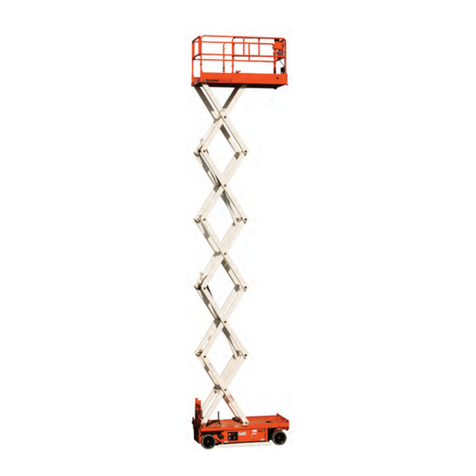
Snorkel
Snorkel S2646E Operator's manual
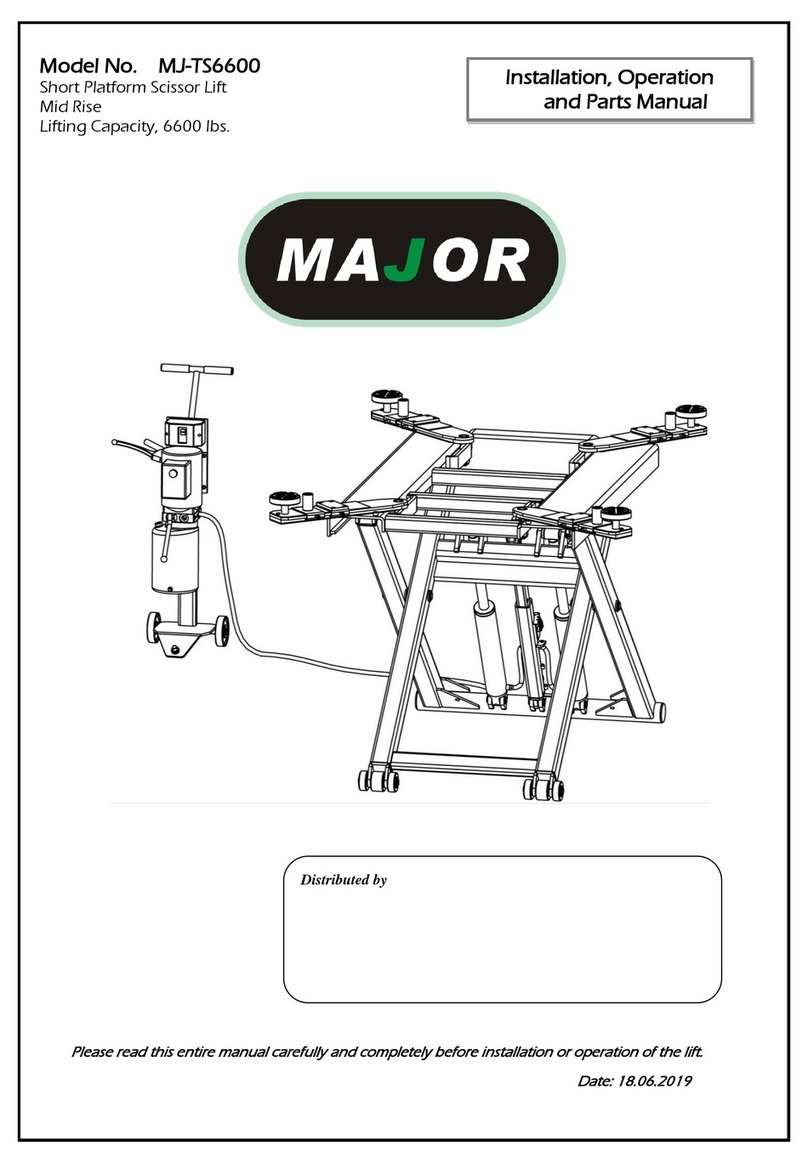
Major
Major MJ-TS6600 Installation, operation, and parts manual
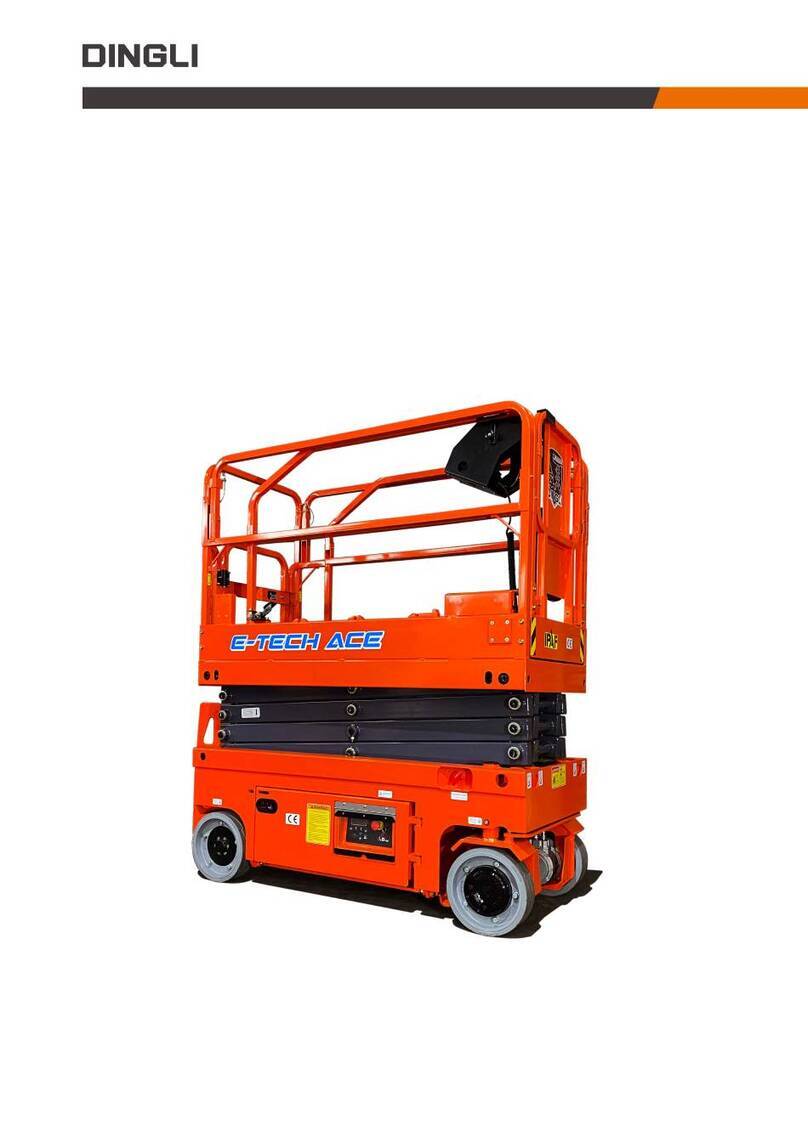
DINGLI
DINGLI E-TECH ACE Series Training manual

Bike-Lift
Bike-Lift TWIN-ARMS MTA 516 Use and maintenance manual
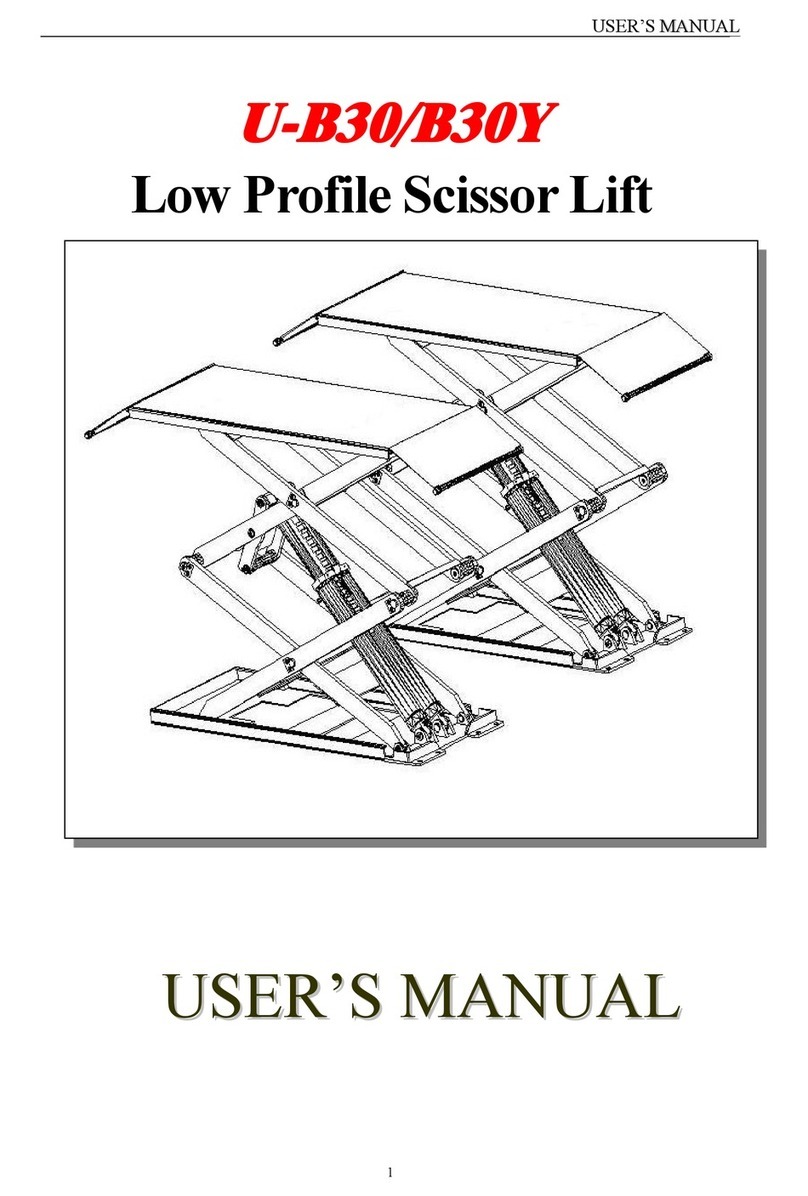
LINCOS
LINCOS U-B30 user manual
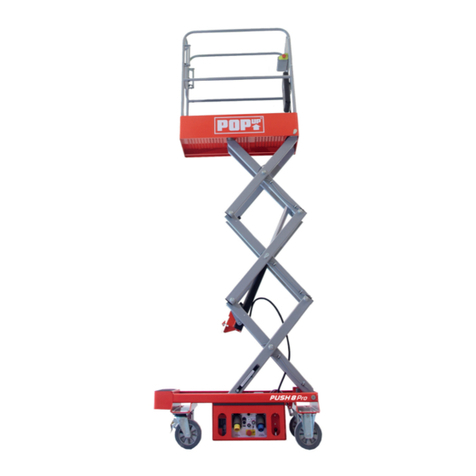
POP UP
POP UP PUSH 6 PRO Operator's Safety and Maintenance Handbook

